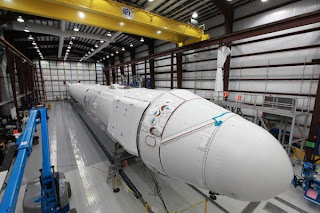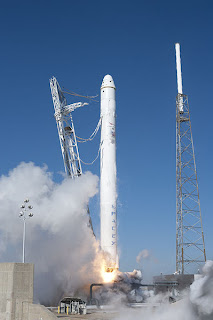NASA's CCD poster, displaying the various commercial projects underway to support the ISS.
With the cancellation of the space shuttle program, America finds itself once again at the unenviable position of lacking a ride into space. The last time this happened was in the 1970's, as the Apollo-Soyuz project came to an end in 1975, the Skylab space station burned up over Australia, and the Moon landings were terminated by a government trying to get out of the Vietnam War. American astronauts did not return to space until the first flight or orbiter Columbia in 1981.
With the destruction of Columbia on mission STS-107 on February 1, 2003, President GW Bush directed NASA to revise the shuttle program and examine the agency's priorities and direction. Eventually it was decided by President Bush in 2005 to cancel the space shuttle program in 2010 once the ISS finished construction. NASA was then directed to use the savings from the termination of space shuttle missions to design and build a new, less expensive rocket system (The Ares-1 rocket and the Orion capsule) for flights to Earth Orbit, as well as a larger heavy lift vehicle (Ares-V) which would lift large satellites, space stations, and lunar explorers into Earth orbit. A plan was developed to build Lunar landers and a base would be placed on the Moon. This plan was called The Vision For Space Exploration and the rocket development program was named the Constellation Program, reminiscent of the Apollo Program and the Saturn series of rockets.
Ares 1-X launch, pad LC-39B, October 28, 2009.
Program patch for the Ares 1-X mission. Collectors, good luck getting this one. At least I've got the pin.
The Constellation program did not succeed as hoped. There were the inevitable delays in design and testing of hardware, the program began running up costs, and there were many disagreements in NASA management and fights between the government and NASA. Basically, when the government tries to make things, it always costs more than they plan. Furthermore, Congress did not provide extra funding for the Constellation program, which meant that as savings from the shuttle retirements failed to be realized, and costs went up on developing new rockets, money had to be found by moving it from other projects. Eventually, only one test flight of the early Ares (Ares 1-X) was performed on October 28, 2009.
President Obama announced the cancellation of the Constellation Program in 2010, but then modified the idea two months later. Gone were any ideas of a program to return to the Moon, plan for Mars, or any part of the Constellation program. Instead, NASA would spend its money on technology development, astronauts would fly to the ISS on Russian rockets, and the ISS would be shut down in 2015. After enormous gasps of shock by the space-supporting public and Congress, the life of the ISS was extended to 2020. A fight in Congress over the change in the program led to... a new change in the program. The White House and the NASA administration developed a plan to give seed funding to private corporations to develop new rockets and capsules to provide America with access to low Earth orbit and the ISS, while NASA would develop the SLS (Space Launch System) heavy lift vehicle, with the goal of eventually exploring deeper space beyond the Moon and perhaps visiting asteroids. (Actually it would take an entire book to cover the history of how the Congress and White House fought over what direction NASA should take.)

Logo for the Commercial Crew Program initiative.
The Commercial Crew and Cargo Program Office, which oversees the seed funding to private companies developing new systems into Earth orbit, is run by NASA and is intended to eventually choose two independent rocket/capsule programs which will support the ISS. This includes cargo delivery as well as an eventual manned crew capability. Since the program began in 2010, there have been some significant developments to the point that there are about seven companies seeking CCD development money. There are actually only a few contenders capable of making the grade in the next little while. This coming weekend, one of the competitors, Space Exploration technologies (SpaceX), will attempt a grand mission to send the first private corporation's cargo craft to dock with ISS and deliver supplies. Also this last week has seen other companies make important announcements about their programs in the new race to put Americans back in space.
While we wait for the SpaceX Dragon launch to the ISS on May 19, I'll cover each of these major CCD programs and give you some links to learn more information. In the meantime, peruse these Wikipedia links on the programs I've mentioned:
Vision for Space Exploration:
http://en.wikipedia.org/wiki/Vision_for_Space_Exploration
Constellation Program:
http://en.wikipedia.org/wiki/Constellation_program
National Space Act of 2010:
http://en.wikipedia.org/wiki/NASA_Authorization_Act_of_2010
Commercial Crew Development:
http://en.wikipedia.org/wiki/Commercial_Crew_Development



















































